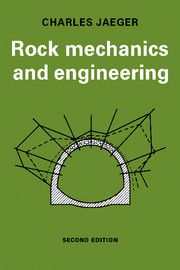Book contents
- Frontmatter
- Contents
- Preface
- Preface to the first edition
- Part 1 Introduction to rock mechanics
- Part 2 Rock material and rock masses
- Part 3 Rock mechanics and engineering
- Part 4 Case histories
- 12 Dam foundations and tunnelling
- 13 Incidents, accidents, dam disasters
- 14 The Vajont rock slide
- 15 Two examples of rock slopes supported with cables
- 16 Three examples of large underground hydro-power stations
- References
- Appendix 1 Comments on the bibliography
- Appendix 2 Measurement conversion tables
- Appendix 3 Table of geological formations and earth history
- Appendix 4 Some petrographic properties of rocks
- Author Index
- Index of geographical names, dam sites, reservoirs, tunnels and caverns
- Subject Index
15 - Two examples of rock slopes supported with cables
Published online by Cambridge University Press: 04 August 2010
- Frontmatter
- Contents
- Preface
- Preface to the first edition
- Part 1 Introduction to rock mechanics
- Part 2 Rock material and rock masses
- Part 3 Rock mechanics and engineering
- Part 4 Case histories
- 12 Dam foundations and tunnelling
- 13 Incidents, accidents, dam disasters
- 14 The Vajont rock slide
- 15 Two examples of rock slopes supported with cables
- 16 Three examples of large underground hydro-power stations
- References
- Appendix 1 Comments on the bibliography
- Appendix 2 Measurement conversion tables
- Appendix 3 Table of geological formations and earth history
- Appendix 4 Some petrographic properties of rocks
- Author Index
- Index of geographical names, dam sites, reservoirs, tunnels and caverns
- Subject Index
Summary
Consolidating a rock spur on the Simplon Pass road
Introduction
The Simplon Pass (2005 m above sea level) was used by the Romans. In the Middle Ages it became a vital route for commercial exchanges between Germany and Northern Italy; German Emperors crossed the pass. The present road was built on Napoleon's orders (1801–5) for military reasons, after he won several battles in north Italy. Since 1968, the road has been systematically improved and enlarged on the Swiss and on the Italian sides, to cope with increasing traffic.
On the south side, near Gondo (Switzerland) the dangerous 50 m high rock spur of Baji–Krachen (at 990 m above sea level) had to be partially cut for a length of about 60 m to achieve straightening and the widening of the road from about 7·70 m to 12 m.
The geologists reported that the rock mass forming the spur is very hard gneiss, cut by three sets of joints, some of them being potentially dangerous.
The structure of the spur
Figure 15.1 shows a typical cross-section of the rock with the three main sets of joints. The joints of set I, inclined at 38° over most of their length, with a steeper dip to 45° at the lower limit, are the most dangerous. The vertical joints belonging to set II could also cause trouble, but mainly where they occur as discontinuous structure underlying more gently dipping joints at the base, and near the face, of the rock mass.
- Type
- Chapter
- Information
- Rock Mechanics and Engineering , pp. 424 - 434Publisher: Cambridge University PressPrint publication year: 1979



